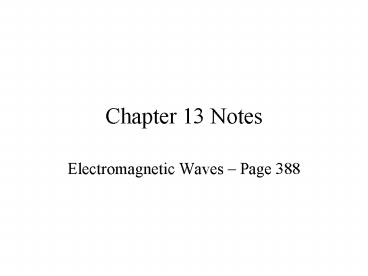Chapter 13 Notes - PowerPoint PPT Presentation
1 / 24
Title:
Chapter 13 Notes
Description:
For Transverse Waves distance from one crest to the next or from one trough to ... Amplitude distance from rest position to the crest or ... Calculation ... – PowerPoint PPT presentation
Number of Views:22
Avg rating:3.0/5.0
Title: Chapter 13 Notes
1
Chapter 13 Notes
- Electromagnetic Waves Page 388
2
Section 1 What are electromagnetic Waves?
- Answer the following questions
- How do electromagnetic waves travel through
space? - How do electromagnetic waves transfer energy to
matter?
3
- Page 332
- Parts of a wave
- I. Transverse Waves have
- A. Troughs low points
- B. Crests high points
- Demo
4
II. Compressional Waves Have
- Rarefactions less dense / less compact regions.
- Compressions dense / compact regions.
- Demo
5
Wavelength
- For Transverse Waves distance from one crest to
the next or from one trough to the next.
6
II. For Compressional Waves
- Wavelength is the distance from one rarefaction
to the next or from one compression to the next. - Frequency number of wavelengths that pass a
fixed point each second measured in units called
hertz (Hz) 1 wavelength per sec.
7
Amplitude and Energy
- Amplitude distance from rest position to the
crest or trough in a transverse wave. - For a compressional wave, amplitude is related
to how dense the compressions are more dense
higher amplitude. - The greater a waves amplitude, the more energy
it carries.
8
Wave Speed
- Wave Speed wavelength x frequency
- v ? x f
- v
- ? f
9
Calculating speed, wavelength and frequency
- To calculate wave speed (v)
- v cover up v
- ? f
? f - Multiply ? and f to calculate wave speed (v).
10
Calculating speed, wavelength and frequency,
continued
- To calculate wavelength (?)
- v cover up ? v
- ? f
f - Divide v by f to calculate wavelength (?).
11
Calculating speed, wavelength and frequency,
continued
- To calculate frequency (f)
- v cover up f v
- ? f
? - Divide v by ? to calculate frequency (f).
12
Section 3 Behavior of Waves
- Page 339
- Reflection light waves bouncing off of an
object. - Refraction bending light waves in a material,
such as water, due to the waves slowing down. - Diffraction bending light waves around an
object.
13
Section 3 Continued
- Interference when two or more waves combine to
form a new wave. - Constructive the wave amplitudes add together.
- Destructive wave amplitudes subtract from each
other. - Standing Waves equal waves traveling in
opposite directions.
14
Nodes
- Places where two standing waves cancel each other
out (Figure 23, page 346). - Resonance the ability of an object to vibrate
by absorbing energy. - Demos
15
Chapter 11 Test Review
- Wave Speed
- Reflection
- Amplitude
- Seismic wave
- Node
- Medium
- Diffraction
- Frequency
- Fill-in-the-blanks (terms)
- Wave
- Refraction
- Wavelength
- Crest
- Rarefaction
- Transverse wave
- Interference
16
Trough Compression Compressional wave Standing
wave Resonance Angle of incidence Angle of
reflection Normal
17
Matching
- Wavelength
- Frequency
- Wave Speed
- Meter
- Meters / second
- hertz
18
Know the differences among the following terms
- Refraction, reflection, and diffraction
- Transverse, compressional, and seismic waves
- Seismic, tidal, and uniform waves
- Wave speed, wavelength, and frequency
- Antinode, node, and compression
19
Questions
- How do particles move differently in transverse
waves and in surface water waves? - Be able to identify and explain the differences
between transverse waves and compressional waves. - Why dont all loud sounds cause glass objects to
break?
20
Questions, continued
- Be able to answer a question about light waves
passing through a piece of glass at an angle. - In a standing wave, what kind of interference
produces the crests and the nodes?
21
Be able to label the parts of a wave
22
Calculation
- Use the wave speed equation to calculate the
speed, frequency, and wavelength of a wave (You
can use a note card) - Wave Speed wavelength x frequency
- v ? x f
- v
- ? f
23
More Questions
- How do we get moon light?
- How do you know that light is a type of wave that
can travel with out a medium (matter)? - Be able to explain what happen to amplitude,
frequency, and wavelength of a wave when one of
them changes. - Be able to answer a question about refraction.
24
More Questions, Continued
- Be able to answer a question about interference.
- Be able to answer a question about reflection.
- Be able to answer a question about frequencies in
standing waves.































